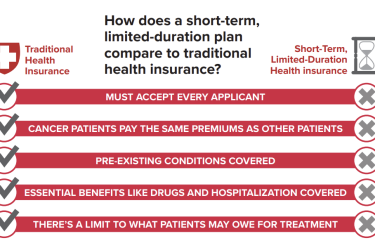
For the past two months, new data on the rate of the uninsured in the United States have reached what appear to be historic levels.
Last week, the U.S. Census Bureau released the latest numbers, reporting that the percentage of Americans who were uninsured last year dropped by 2.9 percentage points from 2013, the largest percentage-point decline since 2008.
In an article for Kaiser Health News, Julie Rovner went further, quoting Paul Fronstin, director of health research for the Employee Benefit Research Institute. The decline of almost 3 percent is, “probably the biggest drop ever,” Fronstin said.
In 2013, the year before the Affordable Care Act’s individual mandate became effective, 86.7 percent of Americans had health insurance, the Census Bureau reported. In that year, 13.3 percent of Americans (41.8 million individuals) were uninsured.
One year later, 10.4 percent of Americans (33 million individuals) were uninsured, meaning the rate of Americans who had health insurance coverage at some point during the calendar year was 89.6 percent after 8.8 million gained health insurance coverage. This increase, “is unprecedented since the creation of Medicare and Medicaid 50 years ago,” Rovner added.
Last month, a different federal analysis showed the uninsured rate among all Americans in the first quarter of this year dropped to 9.2 percent, the lowest rate since 1972, Reena Flores reported for CBS News. That number comes from the latest report from the National Health Interview Survey from the federal Centers for Disease Control and Prevention’s National Center for Health Statistics. We covered the CDC report here.
In coverage for Vox and Forbes, Dan Diamond pointed out that the CDC’s research was the first major survey ever to show more than 90 percent of Americans with health insurance.
Among these two significant reports, the Census Bureau numbers are particularly important, as my colleague Susan Heavey explained last week, and because they give us a baseline to evaluate trends in the future. The bureau’s report shows, for example, that employer-based insurance covered the most people (55.4 percent of the U.S. population), Medicaid covered 19.5 percent, Medicare covered 16 percent and individuals who purchased insurance directly represent 14.6 percent. It also shows that the uninsured rate dropped in every state and the District of Columbia.
Also, the report breaks out the uninsured rate by household income in 2013 and 2014, by place of birth for both years, by race and Hispanic origin for both years and the uninsured rate by state for 2014. In addition, it provides data on the decrease in the uninsured rate by state from 2013 to 2014, the uninsured rate by state and Medicaid expansion status for 2014 and for 2013 compared with 2014 and the uninsured rate by poverty status and state Medicaid expansion for adults aged 19 to 64 years old for 2013 and 2014.
For journalists covering the issue of Medicaid expansion, this report may prove useful. It shows, for example, that the uninsured rate in 2014 was 9.8 percent in Medicaid expansion states and 13.5 percent in states that did not expand Medicaid eligibility. Among Medicaid-expansion states, Massachusetts had the lowest uninsured rate (3.3 percent) and Nevada the highest rate (15.2 percent). In non-expansion states, Wisconsin was lowest (7.3 percent) and Texas the highest (19.1 percent).








